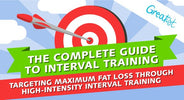
High-Intensity Interval Training (H.I.I.T)
, by Cheri Rifkin, 3 min reading time

, by Cheri Rifkin, 3 min reading time
One of my favorite ways to utilize workout time effectively is to do intervals. Years ago, I used intervals to increase my fitness (and decrease my time) in triathlon while swimming, cycling and running. Intervals are also an efficient use of time on indoor stationary equipment such as stair climbers, treadmills and spin bikes.
High-intensity interval training is a great exercise that combines two the most effective fat-burning methods. Who doesn’t want to get the most out of their workouts?
The high-intensity part pushes the body to its maximum effort to achieve muscle fatigue and maximum oxygen use in short bursts. You must push yourself to your limit and not hold back. You’ll increase your VO2 max, which is the highest amount of oxygen your body will consume during exercise, and continue to burn calories for up to 48 hours after your workout. This is called the “afterburn effect”.
The interval training part alternates periods of intense effort with periods of low-moderate intensity effort. Metabolism is boosted much longer than if you were to do steady intensity, such as walking on a treadmill for 30 minutes at the same pace. Interval training also builds lean muscle tissue faster than steady state training.
By combining these two forms of training, we can maximize fat-burning, build lean muscle and increase calorie burn during and after shorter workouts!
Studies have shown that HIIT done three times per week for as little as 30 minutes will produce the same anaerobic and aerobic improvement as one hour of steady state cardio five times per week! This is very good news for those of us who juggle work, family and fitness or for those who don’t love to exercise just for the fun of it.
Here are brief explanations of the more popular HIIT methods:
HIIT is a very effective method for improving fitness in a short period of time but can be hard on the body. Start gradually…you’ll love the results!
 Source: Greatist.com, Health and Fitness News & Tips
Source: Greatist.com, Health and Fitness News & Tips


![PRōZE Review [2020 Update]](http://hihealth.com/cdn/shop/articles/cbd_insider_article_graphic_featured_image-11.jpg?v=1591495027)